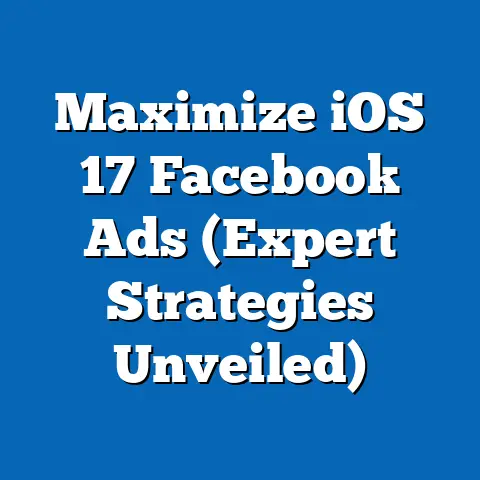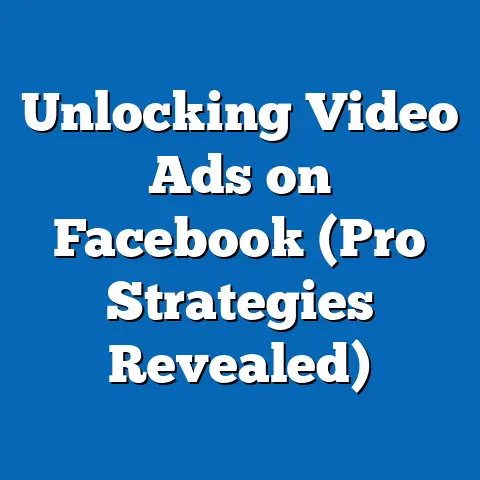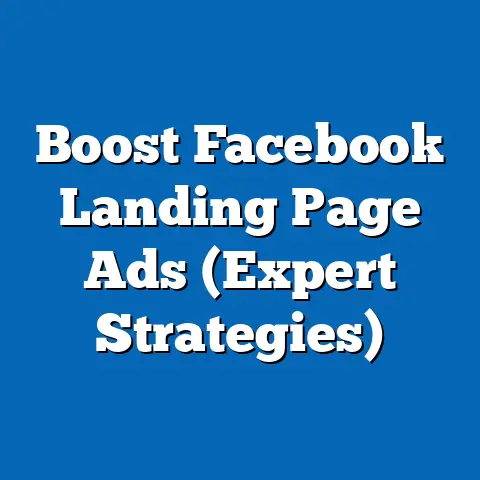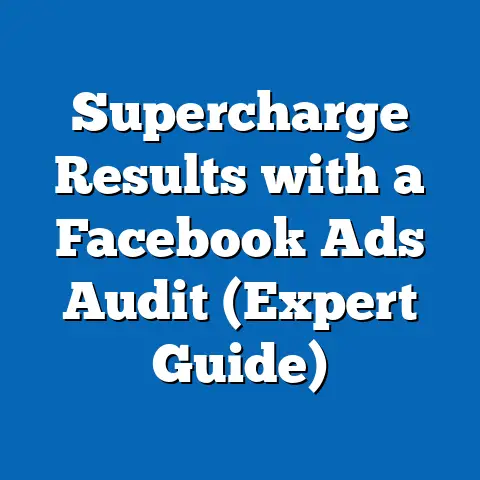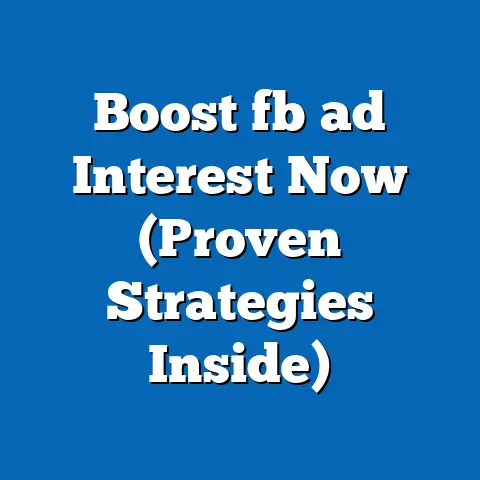Stop Facebook Ad Now (Expert Tips for Success)
Do you remember the thrill of launching your very first Facebook ad and watching the engagement roll in like clockwork? I do! Back in the day, it felt like you could throw a few bucks at a campaign and watch the leads come flooding in. But times have changed. Facebook advertising, once a relatively straightforward path to reach a massive audience, has become a complex and competitive landscape. Today, it’s crucial to constantly adapt and refine your strategies to achieve success. Sometimes, that means hitting the pause button on your current campaigns and reassessing your approach. Let’s dive into why that might be the case and what you can do about it.
Understanding the Facebook Advertising Landscape
The Facebook advertising landscape has undergone a dramatic transformation since its inception. Initially, it was a relatively untapped market, offering advertisers an almost unfair advantage. Remember those early days? Organic reach was high, and ad costs were low. It felt almost too easy.
However, as Facebook’s user base exploded, so did the number of businesses vying for their attention. This surge in competition has led to several key changes:
- Increased Ad Costs: More advertisers mean higher bids for ad placements, driving up the cost per click (CPC) and cost per thousand impressions (CPM).
- Algorithm Updates: Facebook constantly tweaks its algorithms to improve user experience, which can significantly impact ad visibility and reach.
- Stricter Ad Policies: Facebook has tightened its ad policies to combat misinformation and protect user privacy, making it more challenging to get ads approved and maintain compliance.
- Evolving User Behavior: User preferences and engagement patterns are constantly shifting, requiring advertisers to stay agile and adapt their messaging accordingly.
Staying updated with Facebook’s ever-evolving algorithms and advertising policies is paramount. I’ve seen countless businesses, including my own earlier ventures, struggle because they stuck to outdated strategies. What worked six months ago might be completely ineffective today. That’s why continuous learning and adaptation are non-negotiable in the world of Facebook advertising.
Why It Might Be Time to Stop Your Current Facebook Ads
There comes a point in every advertising campaign when you need to ask yourself: “Is this still working?” Holding onto a failing strategy is like throwing good money after bad. Here are some telltale signs that it might be time to stop your current Facebook ads:
- Declining Engagement Rates: Are you seeing fewer likes, comments, and shares on your ads? This could indicate that your audience is no longer resonating with your messaging or creative.
- Rising Costs Per Click (CPC): If your CPC is steadily increasing without a corresponding increase in conversions, it’s a clear sign that your ads are becoming less efficient.
- Poor Conversion Rates: Are you driving traffic to your website, but visitors aren’t converting into leads or sales? This suggests a disconnect between your ad messaging and your landing page experience.
- Low Relevance Scores: Facebook assigns a relevance score to each ad based on its expected engagement. A low score indicates that your ad is not relevant to your target audience, leading to higher costs and lower reach.
- Ad Fatigue: Even the best ads can lose their effectiveness over time as your audience becomes desensitized to them. If you’re running the same ads for too long, you may experience ad fatigue, resulting in declining performance.
I remember working with a client whose Facebook ads were performing exceptionally well for several months. Suddenly, their engagement plummeted, and their CPC skyrocketed. After analyzing their data, we realized that their audience had simply become tired of seeing the same ads. We paused their campaigns, refreshed their creative, and saw an immediate improvement in performance.
Analyzing your ad performance data is crucial to determine when to pause or stop campaigns. Don’t rely on gut feelings or assumptions. Dig into the numbers and look for patterns and trends. Use Facebook Ads Manager to track key metrics like impressions, reach, engagement, CPC, CPM, and conversion rates.
Key Takeaway: Don’t be afraid to pull the plug on underperforming ads. Sometimes, the best course of action is to stop, reassess, and start fresh.
Identifying Alternative Strategies
So, you’ve decided to stop your current Facebook ads. Now what? The good news is that there are plenty of alternative strategies you can explore to reach your target audience and achieve your marketing goals.
- Explore Other Social Media Platforms: Facebook isn’t the only game in town. Consider diversifying your advertising efforts by exploring other social media platforms like Instagram, TikTok, LinkedIn, and Twitter. Each platform has its unique strengths and caters to different demographics.
- Instagram: Ideal for visually appealing content and reaching a younger audience.
- TikTok: Perfect for short-form video content and engaging with Gen Z.
- LinkedIn: Best for B2B marketing and reaching professionals.
- Twitter: Great for real-time updates, news, and engaging in conversations.
- Diversify into Content Marketing: Creating valuable and informative content can attract and engage your target audience organically. Content marketing can take many forms, including blog posts, articles, videos, infographics, and podcasts.
- Invest in SEO: Optimizing your website and content for search engines can drive organic traffic and improve your visibility in search results. SEO is a long-term strategy that requires patience and consistency, but it can deliver sustainable results.
- Email Marketing: Building an email list and sending targeted email campaigns can be a highly effective way to nurture leads and drive sales. Email marketing allows you to communicate directly with your audience and personalize your messaging.
- Influencer Marketing: Partnering with influencers who have a strong following in your niche can help you reach a wider audience and build credibility. Influencers can promote your products or services through sponsored posts, reviews, and giveaways.
- Instagram: Ideal for visually appealing content and reaching a younger audience.
- TikTok: Perfect for short-form video content and engaging with Gen Z.
- LinkedIn: Best for B2B marketing and reaching professionals.
- Twitter: Great for real-time updates, news, and engaging in conversations.
I once worked with a small e-commerce business that was struggling to generate sales through Facebook ads. We decided to shift their focus to content marketing and SEO. We created a series of blog posts and videos that addressed common questions and pain points in their target audience. Within a few months, their organic traffic had increased significantly, and they were generating more leads and sales than ever before.
Pivoting from Facebook ads to other forms of digital advertising requires a strategic approach. Start by identifying your target audience and understanding their preferences and behaviors. Then, choose the platforms and strategies that are most likely to resonate with them. Finally, track your results and make adjustments as needed.
Key Takeaway: Don’t put all your eggs in one basket. Diversifying your marketing efforts can help you reach a wider audience and reduce your reliance on Facebook ads.
Optimizing Future Facebook Ads
If you’re not ready to abandon Facebook ads altogether, there are several steps you can take to optimize your campaigns and improve their performance.
- Refine Your Targeting: Make sure you’re targeting the right audience with your ads. Use Facebook’s detailed targeting options to narrow down your audience based on demographics, interests, behaviors, and more.
- Experiment with Creative Ad Formats: Facebook offers a variety of ad formats, including image ads, video ads, carousel ads, and collection ads. Experiment with different formats to see which ones resonate best with your audience.
- A/B Testing: A/B testing involves creating multiple versions of your ads and testing them against each other to see which ones perform best. Test different headlines, images, ad copy, and calls to action.
- Improve Your Landing Page Experience: Make sure your landing page is relevant to your ad messaging and provides a seamless user experience. Your landing page should be optimized for conversions, with a clear call to action and a simple checkout process.
- Retargeting: Retargeting involves showing ads to people who have previously interacted with your website or Facebook page. Retargeting can be a highly effective way to re-engage potential customers and drive sales.
I always recommend A/B testing, even for small changes. You’d be surprised how much a simple tweak to your headline or image can impact your ad performance.
Here are a few examples of successful campaigns that have implemented these tips effectively:
- Dollar Shave Club: Dollar Shave Club is known for its humorous and engaging video ads. They use A/B testing to optimize their ad copy and targeting, resulting in high conversion rates.
- Airbnb: Airbnb uses retargeting to show ads to people who have previously searched for accommodations on their website. This helps them re-engage potential customers and drive bookings.
- Nike: Nike uses carousel ads to showcase multiple products in a single ad. This allows them to highlight a variety of options and appeal to a wider audience.
Key Takeaway: Optimization is an ongoing process. Continuously test, refine, and improve your Facebook ads to maximize their performance.
The Importance of Audience Understanding
At the heart of every successful Facebook advertising campaign lies a deep understanding of the target audience. You can’t create effective ads if you don’t know who you’re trying to reach.
Here’s how to gather data on audience preferences and behaviors:
- Facebook Audience Insights: This tool provides valuable data on your target audience, including demographics, interests, behaviors, and more.
- Website Analytics: Use tools like Google Analytics to track user behavior on your website, including the pages they visit, the products they view, and the actions they take.
- Customer Surveys: Send out surveys to your existing customers to gather feedback on their preferences, needs, and pain points.
- Social Media Listening: Monitor social media conversations to see what people are saying about your brand, your industry, and your competitors.
Segmenting your audiences and tailoring your ads to meet their specific needs is crucial. For example, you might create separate ad campaigns for different age groups, genders, or interests.
Key Takeaway: The more you know about your audience, the better you can tailor your ads to resonate with them.
Leveraging Facebook’s Advanced Features
Facebook Ads Manager offers a wealth of advanced features that can help you enhance your ad performance.
- Custom Audiences: Create custom audiences based on your existing customer data, such as email lists, phone numbers, or website visitors.
- Lookalike Audiences: Create lookalike audiences based on your custom audiences. Facebook will identify users who share similar characteristics with your existing customers.
- Retargeting: Show ads to people who have previously interacted with your website or Facebook page.
- Facebook Pixel: The Facebook Pixel is a code snippet that you can install on your website to track conversions and optimize your ad spend.
I’ve seen firsthand how powerful these features can be. For example, I worked with a client who was struggling to generate leads through Facebook ads. We created a custom audience based on their existing customer email list and then created a lookalike audience based on that custom audience. We targeted our ads to the lookalike audience, and their lead generation skyrocketed.
The Facebook Pixel plays a crucial role in tracking conversions and optimizing ad spend. It allows you to see which ads are driving the most conversions and adjust your campaigns accordingly.
Key Takeaway: Don’t be afraid to experiment with Facebook’s advanced features. They can help you reach a wider audience and improve your ad performance.
Staying Ahead of Trends
The world of digital advertising is constantly evolving, so it’s essential to stay ahead of the curve.
Here are some emerging trends in digital advertising:
- Video Content: Video content is becoming increasingly popular on social media. Create engaging video ads that capture your audience’s attention.
- Influencer Partnerships: Partner with influencers who have a strong following in your niche.
- Interactive Ads: Interactive ads, such as polls and quizzes, can increase engagement and drive conversions.
- Augmented Reality (AR): AR ads allow users to interact with your products in a virtual environment.
- Personalization: Personalize your ads based on user data and behavior.
Staying informed about changes in user behavior and platform updates is crucial. Follow industry blogs, attend webinars, and network with other marketers.
Key Takeaway: Embrace change and stay open to new ideas. The most successful marketers are those who are willing to adapt and experiment.
Conclusion
In the fast-paced world of digital marketing, adaptability is key. Sometimes, the most effective strategy is to stop, reassess, and pivot. Don’t be afraid to pause your current Facebook ads if they’re not delivering the results you need. Explore alternative strategies, optimize your future campaigns, and stay informed about emerging trends. By following these expert tips, you can achieve long-term success in the ever-evolving world of Facebook advertising.
Now, I encourage you to take a critical look at your current Facebook ad strategies. Are they truly working for you? Are you seeing the ROI you expect? If not, it might be time to hit the pause button and consider the expert tips I’ve shared. Remember, success in Facebook advertising isn’t about blindly following the same old playbook. It’s about understanding the landscape, adapting to change, and always striving to improve. Good luck!

